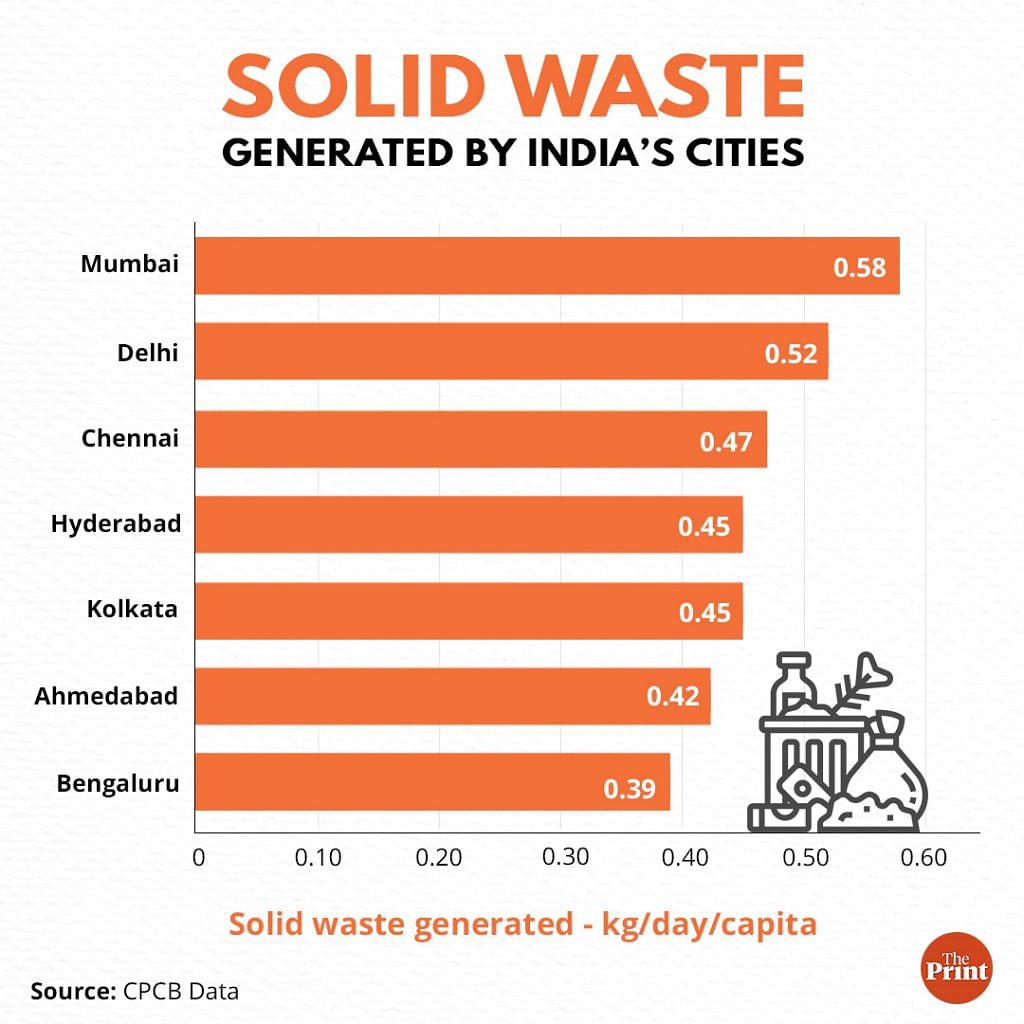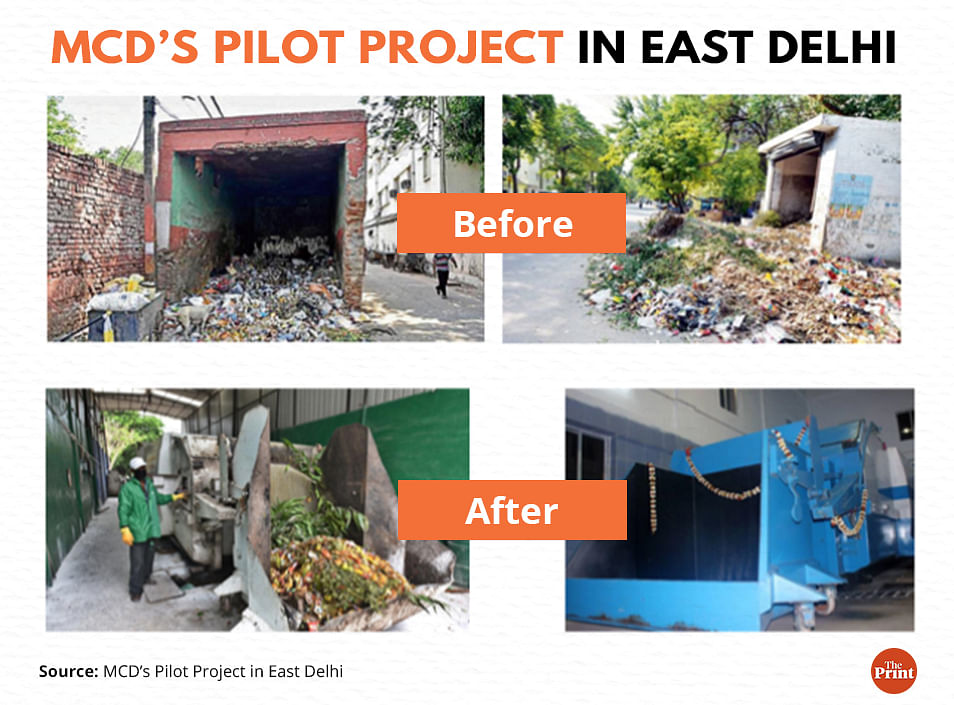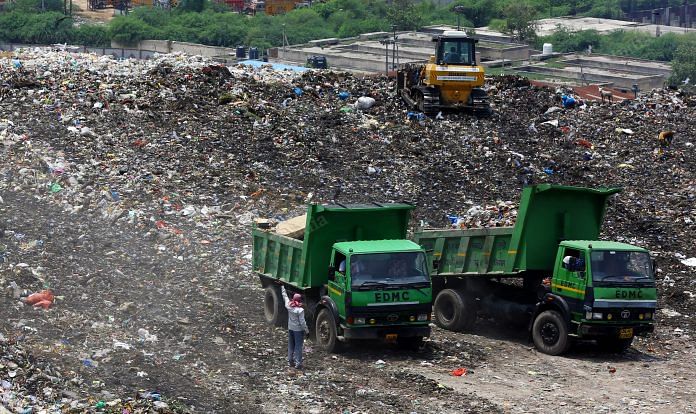As per Article 243W in Schedule XII of the Indian Constitution, solid waste management is the basic essential and obligatory service that has to be provided by a municipal authority. However, it has consistently remained one of the most neglected areas of Delhi’s inefficient and fragmented municipal system.
Mountains of waste
According to the Delhi Pollution Control Committee (DPCC), 10,990 metric tonnes (MT) of solid waste is generated per day in Delhi. Of this, around 51 per cent is sent, unprocessed, to the landfills, while the remaining 49 per cent is treated in waste-to-energy (WTE), composting or refuse-derived-fuel (RDF) plants.
However, this is a conservative estimate. Multiple studies show that the actual amount of solid waste generated per day is close to 15,000 MT per day. Of this, only about 60-70 per cent is collected, while the rest is left on the streets or waste receptacles (dhalaos). It is estimated that by 2024, solid waste generated in Delhi per day will increase by 4.74 per cent (CAGR) given the rise in disposable incomes, wide proliferation of single-use plastic, and planned obsolescence.

Also read: Will convert garbage mountains into green zones in three years, says PM Modi
What led to this
- Multiplicity of authorities
When it comes to solid waste management, there are 8 authorities involved: Municipal Corporation of Delhi (MCD); New Delhi Municipal Council (NDMC); Delhi Cantonment Board (DCB); Delhi Development Authority (DDA); Urban Development (UD) department and Irrigation & Flood Control (I&FC) department of Government of NCT of Delhi (GNCTD); Delhi Pollution Control Committee (DPCC); and Government of India (GoI).
First, MCD is not responsible for solid waste management in the Lutyens’ Delhi area, which lies with NDMC (a nominated body accountable only to the Union Ministry of Home Affairs), and the Cantonment area, which lies with DCB (again a nominated body accountable only to the Union Ministry of Defence).
Second, even though the Secretary of UD and GNCTD is designated as Director, Local Bodies, and is statutorily responsible for coordinating the function of MCD, framing its recruitment rules and resolving inter-authority issues, his position is no more than that of a rubber stamp.
Third, since 1993, it has usually been observed that the political party that comes into power in MCD is different from the one in power in the Delhi government. This, naturally, leads to political skirmishes, theatrical grandstanding, and detrimental non-cooperation from all parties involved.
- Inadequate infrastructure
Delhi has a processing capacity to treat only 6,300 MT of solid waste per day. MCD also has waste receptacles to collect waste from individual generators such as households, markets, institutions, etc.
Clearly, the existing infrastructure is woefully inadequate to meet existing solid waste demands and the rate of establishment of new facilities is snail-paced. But why?
First, in Delhi, land is not a transferred subject and all matters related to land are dealt with by the DDA and not the government. Due to dilatory processes, bureaucratic lethargy, and undesired territorialism, the land management of DDA is found wanting and many of the solid waste management projects initiated by MCD are stuck in limbo, simply due to lack of land transfer or delay in change of land-use.
Second, right from DDA’s Master Plan for Delhi (MPD) 1962 to 2021, spaces allocated for waste management have been, (a) on the outskirts of a district, (b) feasible for setting up plants of large size only. This has not only made Delhi’s waste management system overtly centralised, requiring large tracts of land in a land deficient, land-locked region but has also led to approximately 70-80 per cent of MCD’s budgetary allocation for it to be spent on transportation of waste from the city interiors.
- Burgeoning unsanitary landfills
Currently, there are three landfill sites in operation in Delhi: Ghazipur, Bhalswa, and Okhla.
First, even though all three landfill sites have exhausted their capacity way back, waste dumping still continues leading to overflowing of waste. All the sites are reaching 40-50m height above ground level as against the permissible height of 20m. As a result of indiscriminate and unsanitary dumping and subsequent leachate contamination of groundwater in the area, the health of the citizens living in the vicinity of these landfills has been egregiously damaged.
Second, Solid Waste Management Rules, 2016 state that only non-recyclable, non-biodegradable, and non-combustible waste should go to landfills. However, this is not the case as the waste at Delhi’s landfills has 55-60 per cent bio-degradable/organic material. When this waste decomposes anaerobically, methane is generated, which catches fire and burns for days on end.
Also read: Solid waste could play an important role in fueling airlines
What Delhi can do
- Single, centralised SWM agency
Even though the execution of solid waste management projects would be done individually by each of the authorities involved, common functions like planning, establishment of SWM facilities, allotment of land, and framing of bye-laws should be delegated to a centralised agency. This agency should also be responsible for resolving intra-authority disputes in a time-bound manner (as dictated by a charter) with imposition of heavy penalties on all parties involved (even the centralised agency itself) in case of unnecessary delays.
The agency should be headed by the Lieutenant-Governor (L-G) who is also the central administrative head of NCT of Delhi, chief administrator of MCD, head of NDMC, and chairman of DDA. Reporting to the LG should be an executive board comprising senior-most officials from all the eight authorities. Assisting the executive board should be a Core Management Unit (CMU) that will be responsible for formulation of centralised policy, administrative, revenue, land and oversight functions. Below the CMU, there should be 12 cross-functional Strategic Performance Units (SPUs), one for each of MCD’s 12 zones.
- Decentralised SWM processing facilities
To overcome constraints of land and to prevent waste from reaching landfills, waste processing plants (in the range of 5-500 MT/day) should be established at the municipal ward level. These plants can easily be established in existing dhalaos via retrofitting and will have segregation, compacting, composting and processing facilities – all in-house. New Moti Bagh has an excellent such in-house SWM processing facility.

These decentralised facilities should be created in private-public partnership mode, with no OPEX (operational expenditure) incurred by the MCD. Viability gap funding can be provided by the Centre under Swachh Bharat Mission.
- Phased removal of landfills
First, saturated landfills should be retired and covered with soil like the Indraprastha Park, which was a landfill for 20 years.
Second, Bio-CNG plants (like Asia’s largest at Indore) should be constructed to effectively channel Landfill Gas (LFG) and biodegradable waste.
Third, new landfills should be constructed at the outer edges of Delhi. However, unlike the current ‘unplanned’ landfills, these should be constructed in a scientific manner like the Seropedica landfill in Brazil.
- Efficient waste collection
Instead of collecting waste itself, the MCD should hire a private concessionaire to do this work who should be paid on the basis of a single factor—the amount of waste lifted per day—to increase efficiency. Depending upon the quantum of waste, the private concessionaire can take the waste either to the decentralised waste processing plants or to transfer stations.
This will also help in promoting segregation at the household level and eliminate the local rag-picker who more often than not dumps the collected waste at the roadside.
Pranav Jain is an independent columnist. Views are personal.






